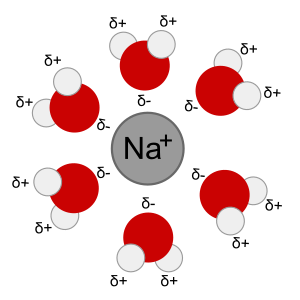محلول مائي

المحلول المائي aqueous solution هو محلول يكون فيه المذيب هو الماء. ويظهر في الأغلب في المعادلات الكيميائية بالتذييل (aq) إلى الصيغة الكيميائية المناسبة. فعلى سبيل المثال، محلول ملح الطعام، أو كلوريد الصوديوم (NaCl)، في الماء سوف يُمثـَّل كالتالي Na+(aq) + Cl−(aq). كلمة مائي aqueous تعني "يتعلق بـ"، أو "يتصل بـ" أو "يشبه" أو "ذائباً في"، الماء. إذ أن الماء هو مذيب ممتاز كما أنه يتواجد بوفرة في الطبيعة، وهو مذيب واسع الانتشار في الكيمياء. المحلول المائي هو ماء بأس هيدروجيني (pH) 7.0 حيث أيونات الهيدروجين (H+) وأيونات الهيدروكسيد (OH-) يكونان في توازن أرهنيوس (10E-7).
المحلول اللامائي non-aqueous هو محلول يكون فيه المذيب سائلاً غير الماء.[1]
المواد التي هي كارهة للماء كثيراً ما لا تذوب جيداً في الماء، بينما أولئك الذين هم المحبون للماء يذوبون جيداً. ومثال للمادة المحبة للماء هو كلوريد الصوديوم. الأحماض والقواعد هي محلولات مائية، كجزء من تعريفات أرهنيوس الخاصة بهم.
قدرة مادة على الذوبان في الماء تتحدد بإذا ما كانت قادرة على أن تعادل أو تفوق قوى الجذب القوية التي تولدها جزيئات الماء فيما بينها. إذا افتقدت المادة القدرة على الذوبان في الماء فإن الجزيئات تكوّن راسب.
Reactions in aqueous solutions are usually metathesis reactions. Metathesis reactions are another term for double-displacement; that is, when a cation displaces to form an ionic bond with the other anion. The cation bonded with the latter anion will dissociate and bond with the other anion.
Aqueous solutions that conduct electric current efficiently contain strong electrolytes, while ones that conduct poorly are considered to have weak electrolytes. Those strong electrolytes are substances that are completely ionized in water, whereas the weak electrolytes exhibit only a small degree of ionization in water.
Nonelectrolytes are substances that dissolve in water yet maintain their molecular integrity (do not dissociate into ions). Examples include sugar, urea, glycerol, and methylsulfonylmethane (MSM).
When writing the equations of aqueous reactions, it is essential to determine the precipitate. To determine the precipitate, one must consult a chart of solubility. Soluble compounds are aqueous, while insoluble compounds are the precipitate. There may not always be a precipitate.
When performing calculations regarding the reacting of one or more aqueous solutions, in general one must know the concentration, or molarity, of the aqueous solutions. Solution concentration is given in terms of the form of the solute prior to it dissolving.
Aqueous solutions may contain, especially in alcaline zone or subjected to radiolysis, hydrated atomic hydrogen an hydrated electron.
See also
- Metal ions in aqueous solution
- Acidity function
- Solubility
- Dissociation (chemistry)
- Acid-base reaction theories
- Properties of water
- Solvated electron
References
هذا article يحتاج المزيد من الأسانيد للتحقق. (April 2011) (Learn how and when to remove this template message) |
- ^ "Solutions". Washington University Chemistry Department. Washington University. Retrieved 13 April 2018.
- Zumdahl S. 1997. Chemistry. 4th ed. Boston: Houghton Mifflin Company. p 133-145.